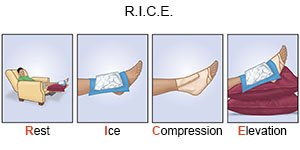Ankle Fracture
Medically reviewed by Drugs.com. Last updated on Aug 4, 2025.
An ankle fracture is a break in 1 or more of the bones in your ankle.
 |
DISCHARGE INSTRUCTIONS:
Call your local emergency number (911 in the US) for any of the following:
- You feel lightheaded, short of breath, and have chest pain.
- You cough up blood.
Seek care immediately if:
- Your leg feels warm, tender, and painful. It may look swollen and red.
- Blood soaks through your bandage.
- You have severe pain in your ankle.
- Your cast feels too tight.
- Your foot or toes are cold or numb.
- Your foot or toenails turn blue or gray.
Call your doctor if:
- Your splint feels too tight.
- Your swelling has increased or returned.
- You have a fever.
- Your pain does not go away, even after treatment.
- You have questions or concerns about your condition or care.
Medicines:
You may need any of the following:
- Acetaminophen decreases pain and fever. It is available without a doctor's order. Ask how much to take and how often to take it. Follow directions. Read the labels of all other medicines you are using to see if they also contain acetaminophen, or ask your doctor or pharmacist. Acetaminophen can cause liver damage if not taken correctly.
- NSAIDs , such as ibuprofen, help decrease swelling, pain, and fever. This medicine is available with or without a doctor's order. NSAIDs can cause stomach bleeding or kidney problems in certain people. If you take blood thinner medicine, always ask your healthcare provider if NSAIDs are safe for you. Always read the medicine label and follow directions.
- Prescription pain medicine may be given. Ask your healthcare provider how to take this medicine safely. Some prescription pain medicines contain acetaminophen. Do not take other medicines that contain acetaminophen without talking to your healthcare provider. Too much acetaminophen may cause liver damage. Prescription pain medicine may cause constipation. Ask your healthcare provider how to prevent or treat constipation.
- Take your medicine as directed. Contact your healthcare provider if you think your medicine is not helping or if you have side effects. Tell your provider if you are allergic to any medicine. Keep a list of the medicines, vitamins, and herbs you take. Include the amounts, and when and why you take them. Bring the list or the pill bottles to follow-up visits. Carry your medicine list with you in case of an emergency.
Self-care:
 |
- Rest your ankle so that it can heal. Return to normal activities as directed.
- Apply ice on your ankle for 15 to 20 minutes every hour or as directed. Use an ice pack, or put crushed ice in a plastic bag. Cover it with a towel. Ice helps prevent tissue damage and decreases swelling and pain.
- Use a support device, such as a brace, cast, or splint to limit your movement and protect your ankle. You may need to use crutches to protect your ankle and decrease your pain as you move around. Do not remove your device and do not put weight on your injured ankle.
- Elevate your ankle above the level of your heart as often as you can. This will help decrease swelling and pain. Prop your ankle on pillows or blankets to keep it elevated comfortably.
Splint and cast care:
Cover the splint or cast before you bathe so it does not get wet. Tape 2 plastic trash bags to your skin above the cast. Try to keep your ankle out of the water as much as possible.
Follow up with your doctor in 1 to 2 days, or as directed:
Your fracture may need to be reduced (bones pushed back into place) or you may need surgery. Write down your questions so you remember to ask them during your visits.
© Copyright Merative 2025 Information is for End User's use only and may not be sold, redistributed or otherwise used for commercial purposes.
The above information is an educational aid only. It is not intended as medical advice for individual conditions or treatments. Talk to your doctor, nurse or pharmacist before following any medical regimen to see if it is safe and effective for you.
Learn more about Ankle Fracture
Treatment options
Care guides
Symptoms and treatments
Medicine.com guides (external)
Further information
Always consult your healthcare provider to ensure the information displayed on this page applies to your personal circumstances.
